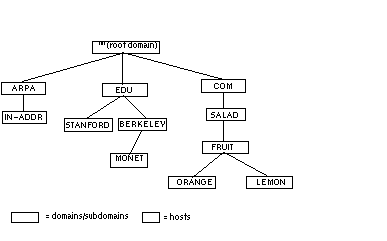
The Domain Name Service eliminates the need for a single, centralized clearinghouse for all names. The authority for this information can be delegated to the organizations on the network that are responsible for it.
The Domain Name Service is organized as a hierarchical name space, like the IRIX file system. Figure 6-1 shows a small section of this hierarchy. Each subtree in the hierarchy is called a domain, and is given a label. At the top of the hierarchy is the root domain, which is labelled with the null label (" "). The name of the domain is the concatenation of all the domain labels from the root to the current domain. The labels are listed from right to left and are separated by dots. (Thus the name for the domain labelled "engr" in Figure 6-1 would be "engr.spices.com".) A label must be unique only within its domain.

Figure 6-1 : Partial View of Domain Name Space Immediately below the root domain is a set of top-level domains. These top-level domains are relatively static, and are administered by the Network Information Center. These are the current top-level domains registered with the Network Information Center:
The whole space is partitioned into several non-overlapping areas of authority called zones. Information in each zone is handled by the zone's "authoritative" or "master" name server(s). Each zone starts at a domain and extends down to the leaf domains, or to domains where other zones start. Zones usually represent administrative boundaries.
An example of a domain name for a station at the University of California, Berkeley is
The top-level domain for educational organizations is edu. Berkeley is a subdomain of edu, and monet is the name of the station.monet.berkeley.edu.